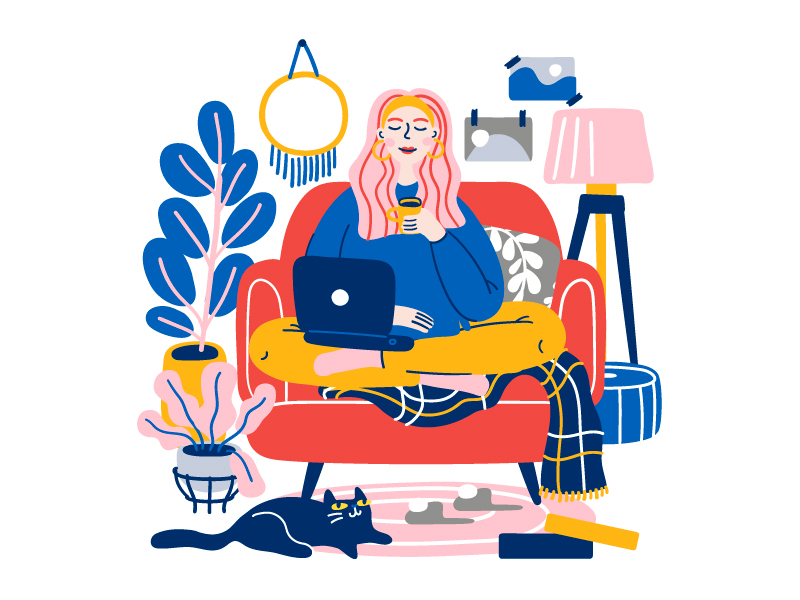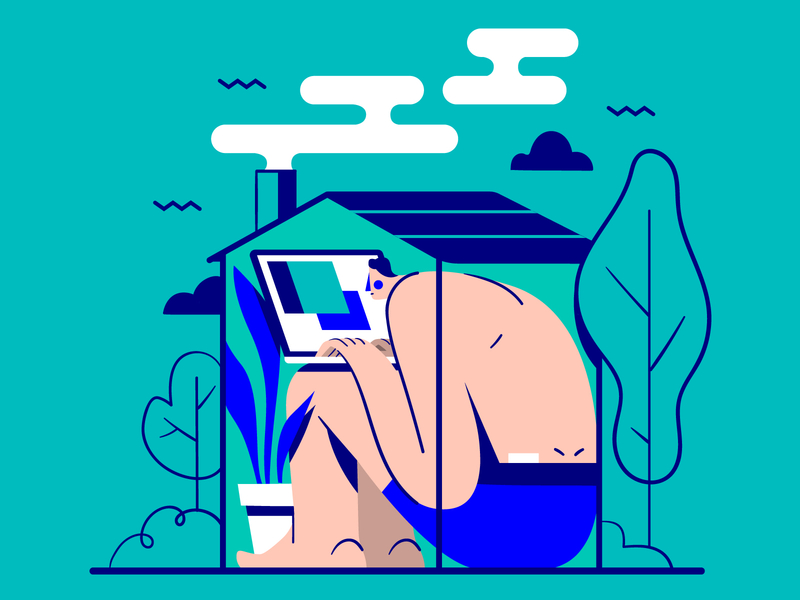In this post by author Cameron Chapman, get advice for fostering more healthy remote work habits and balance your work and personal life.
I’ve been working remotely since 2008, back when most people still thought of “working from home” as stuffing envelopes for pennies per piece or multi-level-marketing schemes. Over that time, I’ve learned a lot of tricks for how to work productively, and even more for how not to work productively (kittens and puppies are both very detrimental to productivity, but very beneficial for mental health; you’ll just have to decide which is more important to you).
Work-life balance has a direct impact on how productive and creative you can be. It can be straightforward to achieve when you work in an office, but once you’re working remotely (as so many people now are in 2020), those lines get blurred. That’s why it’s so important to develop some healthy patterns and habits that will let you maintain balance in your life and work.
Row 1: tubik.arts, Elen Winata, Gaspart.
1. Set a Schedule (and stick to it!)
Having a set work schedule is important for maintaining a work-life balance. But that doesn’t mean you have to stick to the same 9–5 schedule you had when working in an office.
There may be expectations around when you should be available for questions from coworkers or supervisors, but that doesn’t mean you necessarily have to be actively working during those hours. Use communication tools like Slack or email to set expectations around when you’ll be actively working, when you’ll be available for questions or conversations, and when you’re “off the clock.”
Figure out when you’re most productive and design your schedule around that. If you can get tons of work done early in the morning before the rest of your family is awake, then get up at 4 am and work for a few hours. If you find that you work best after 11 am, once you’ve had time to relax, get a workout in, or drink three cups of coffee, then set your schedule around that.
Depending on the expectations of your employer, you might need to clear your schedule with them. But in most cases, as long as you’re responsive to requests from team members, you’ll find that your boss doesn’t care when you’re working as long as the work gets done on time.
When you’re working, it’s a good idea to cut out any distractions (as much as possible) and use something like the Pomodoro method to keep you focused for specific blocks of time. I’m using the Pomodoro method right now while writing this article, and I use it for every part of my workday.
2. Take Breaks
It can be way too easy to fall into the trap of working for hours on end without breaks. When you’re working in an office with other people, you tend to take natural breaks, like when a coworker pops by your desk. But at home, you may not have those natural breaks.
This is another reason to use a structure like the Pomodoro method, which creates automatic 5- and 15-minute breaks during your workday. But if you don’t use a method like that, consider setting a reminder on your phone to take breaks every hour or so. Get up from your desk, stretch, grab some water, step outside, or do whatever you need to do to reset for a few minutes.
Speaking of breaks, try to take an actual lunch break when you don’t work. Eat and then take a walk or spend fifteen minutes reading. Listen to a podcast or watch some YouTube videos (that aren’t work-related).
Regardless of how you take your lunch break, take at least half an hour for yourself to step away from your desk and away from your work. If you can, set yourself to “away” for that time (on Slack or whatever other communication apps you use to keep in touch with work) so that you’re truly able to unplug for a bit.
3. Make Plans After Work
One of the best ways to make sure you stop working at a reasonable time is to make plans after work. That could be a call with a friend or family member, plans to take a walk with someone, a class that you have to attend at a certain time, or any other obligation that you won’t want to miss out on.
One key thing to remember here is that you should go back to work once you’re done for the day. Don’t use these plans as a break; use them as a hard stopping point.
4. Set Aside a Separate Workspace
I know this isn’t possible for everyone, but if you can set aside a specific, separate workspace from the rest of your home it’ll make it significantly easier to leave work at work. If you’re living in a small apartment or home, this doesn’t have to be a completely separate room. It could be a corner of your living room.
If it’s completely impossible to create a separate workspace, think of other ways to separate work from your personal life. One way is to use different profiles on your computer for work versus personal activities. When work is over, log out of your work account and into your personal account if there are things you need to do online for your personal life. If you don’t need to use your computer for personal activities, even just the act of closing your laptop or turning off your desktop can create mental space.
Another useful tool is to set “do not disturb” or “away” times in the phone apps you use for work. When your workday is over, you’ll stop getting notifications from things like Slack, letting you leave work at work.
5. Create Rituals to Start and Stop Your Work Day
I once had a boss who started every day by taking a walk before work. She used this as a virtual “commute” even though she was returning to her apartment to start work. She said that establishing that ritual helped her immediately shift into “work mode” upon returning home.
Think of things you can do every day that signal to your brain that it’s time to start or stop work. For me, I always start my day by stepping outside for a few minutes before coming inside to make coffee. As soon as my coffee is done I go to my desk and start my first Pomodoro period for the day. Even if there are other things I want or need to do in the morning, starting with fresh air + coffee + work gets my brain in the right place for a productive day.
The same goes for stopping your day. Maybe it’s closing your laptop when work is done. Or it could be taking a walk or drive. Whatever it is, choose something you can do consistently that tells your brain, “Okay, work is over, let’s focus on other things.”
6. Set Boundaries (and enforce them)
It’s important to set boundaries, both for yourself and others. If you’re not available after 6 pm or on weekends, for example, don’t make exceptions unless it’s a dire emergency that no one else can handle.
It can be too easy to fall into the trap of thinking that something will only take you a few minutes to complete, so it’s no big deal to just deal with it at 7 pm on a Saturday. But then you’ve set an expectation that you’re always available to “do something real quick” at 7 pm on Saturdays. Don’t fall into that trap.
At the same time, make sure you’re respecting the boundaries your coworkers have set. If they say they’re not available at certain times or on certain days, don’t email them and ask them to make an exception “just this one time.”
7. Figure Out Your Peak Productive Hours
I already touched on this in the setting a schedule part, but I can’t emphasize enough how important it is to figure out when you’re at peak productivity. Studies have shown that we only have about four hours of peak creativity every day. That means you have four hours to focus on getting your design or other creative projects done before you’re effectively just spinning your wheels.
Think about what times during the day you feel most focused and energized about your work, and which times you start to drag. For me, it’s first thing in the morning until early or mid-afternoon, and then I get another burst of creativity and energy late at night (after 10 pm). I take advantage of those time periods to make sure my most creative work is done then. Save checking email or other administrative tasks for outside of those hours.
Work-Life balance is vital to productivity
If you want to be super productive when working remotely, I can’t underemphasize the importance of maintaining balance between your work life and your personal life. Working too much can quickly lead to burnout. Even if it doesn’t go that far, your productivity and especially your creativity will suffer if you don’t establish and abide by your own boundaries.
You’ll do better work when your work isn’t taking over your entire life ■
![]() About the Author — Cameron Chapman: Editor. Blogger. Author. Designer. Copywriter. Marketer. Entrepreneur. Speaker. Consultant. Coach. I wear a lot of hats. What most of them have in common, though, is storytelling.
About the Author — Cameron Chapman: Editor. Blogger. Author. Designer. Copywriter. Marketer. Entrepreneur. Speaker. Consultant. Coach. I wear a lot of hats. What most of them have in common, though, is storytelling.
RELATED READING
- How to feel your best & make the most out of working from home
- Top 5 challenges of working remotely & how to overcome them
- Is remote work right for you? 3 questions to ask yourself
- WFH Goals: 10 freelance designers share their unique home workspaces
- 3 factors designers should consider when setting up a remote workspace
- 7 freelance graphic designers share their daily routines
Find more Community stories on our blog Courtside. Have a suggestion? Contact stories@dribbble.com.
















